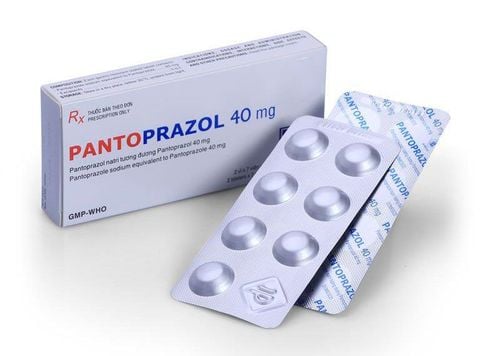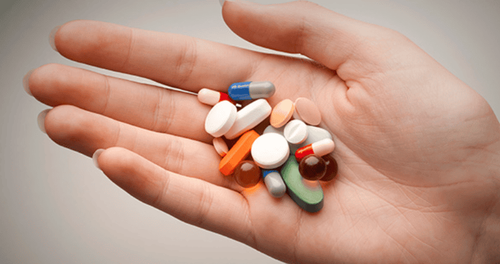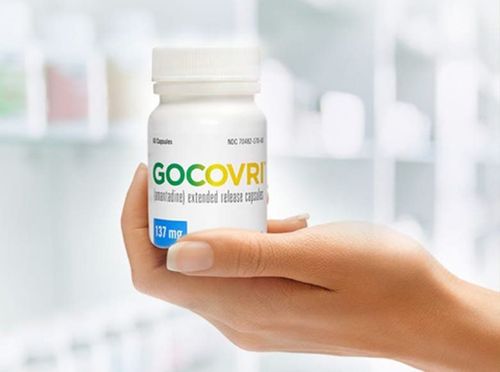This is an automatically translated article.
The main ingredient of Sifrol is Pramipexole. It is indicated for the treatment of the signs and symptoms of idiopathic Parkinson's disease and restless leg syndrome.1. What is Sifrol?
The active ingredient Sifrol is Pramipexole. Pramipexol is a dopamine agonist, Pramipexole binds selectively and highly specifically to the dopamine D2 receptor subtype, has a preferential affinity for the D3 receptor, and has complete intrinsic activity. Pramipexol, by stimulating dopamine receptors in the striatum, alleviates the motor deficits of Parkinson's patients.2. Uses of Sifrol
Indications Sifrol is indicated for use in the following cases: symptoms and signs of idiopathic Parkinson's disease. Sifrol can be used as monotherapy or in combination with Levodopa. Sifrol can also be used throughout the course of treatment, until the late stage when levodopa fades or becomes unstable and there is a fluctuation in the therapeutic effect.
Contraindications Contraindicated to use Sifrol in cases of allergy or hypersensitivity to Pramipexol or any of its ingredients.
Do not use the drug for children because there are not enough studies on the effectiveness and safety of using the drug in this group of people.
3. How to take Sifrol
Sifrol extended-release tablets are an oral dosage form that should be taken only once a day and taken daily at a certain time. Sifrol tablets should be swallowed whole with water, do not chew, split or crush the tablet. Sifrol can be taken with or without food.
Parkinson's disease: daily dose is divided equally to take 3 times a day for tablets.
3.1 Dosage in Parkinson's patients
Initial treatment Sifrol dose is gradually increased. Initial dose: 0.375mg/day, then gradually increase dose every 5-7 days. During the use of the drug, if the patient does not experience too unpleasant side effects, the dose should be adjusted until the maximum therapeutic effect is achieved.
Schedule to increase dose of Sifrol slow-release tablets: week 1: 0.375mg/day; week 2: 0.75mg/day; Week 3: 1.5mg/day. If further dose increases are required, increase the daily dose by 0.75 mg saline weekly up to a maximum dose of 4.5 mg saline per day. It should be noted that the incidence of somnolence increases with doses greater than 1.5 mg/day.
Patients taking Sifrol tablets can switch to SIFROL extended-release tablets overnight with the same daily dose. After the patient is switched to the extended-release tablet, the dose is adjusted according to the patient's response to therapy.
Maintenance Treatment The maintenance dose for the patient should be in the range of 0.375mg to a maximum of 4.5mg salt per day. Further dose adjustments should be based on the individual patient's clinical response and occurrence of adverse events. In clinical studies, approximately 5% of patients were treated at doses lower than 1.5 mg of saline per day.
In the treatment of advanced Parkinson's disease, doses higher than 1.5 mg of saline per day may be useful when it is intended to reduce levodopa therapy in patients. It is recommended that patients reduce the dose of Levodopa in the event of an increase in dose or on maintenance therapy with Sifrol, depending on individual patient response.
Discontinuation of treatment Abrupt discontinuation of dopaminergic therapy may result in the development of an antipsychotic malignant syndrome. Therefore, the dose of Pramipexole should be gradually reduced at 0.75 mg/day until the daily dose is reduced to 0.75 mg saline. Thereafter, the dose was reduced by 0.375 mg of the salt form per day.
Patients with renal impairment
Pramipexole elimination is dependent on renal function. Recommended dosage of Sifrol at initiation of therapy:
Creatinine clearance > 50 mL/min: no need to reduce dose or frequency of daily dosing.
Creatinine clearance 20 - 50 mL/min: For extended-release tablets: start with 0.375 mg saline per day. Assess response to treatment and tolerability of Sifrol extended-release tablets before increasing the daily dose each week. If further dosage increases are necessary, the dose should be increased by 0.375 mg per week to a maximum of 2.25 mg of saline per day. For tablets: the starting dose of SIFROL should be divided orally twice a day, starting with a dose of 0.125 mg saline x 2 times/day (0.25 mg salt/day). The maximum dose should not exceed 2.25mg salt form per day.
Creatinine clearance < 20 mL/min: The use of Sifrol extended-release tablets is not recommended in this patient population due to inadequate data. Tablets: start with 0.125mg salt once daily. The maximum dose should not exceed 1.5mg of the salt form per day.
If renal function declines during maintenance therapy with Sifrol, the daily dose should be reduced in proportion to the decrease in creatinine clearance. This means that if creatinine clearance is reduced by 30%, the daily dose of Sifrol will also be reduced by 30%.
Patients with hepatic impairment
No dose adjustment is required in patients with hepatic impairment, as approximately 90% of the absorbed active ingredient Pramipexole is excreted by the kidneys. However, the effect of impaired hepatic function on the pharmacokinetics of pramipexole has not been studied.
Restless legs syndrome
Sifrol tablets are recommended to be used in this case.
The starting dose is 0.125 mg orally saline x 1 time/day, 2 - 3 hours before bedtime. For patients requiring additional symptom relief, the dose may be increased every 4 to 7 days to a maximum of 0.75 mg saline/day.
Since the long-term efficacy of Sifrol in the treatment of "restless legs syndrome" has not been fully studied, the patient's response should be assessed after three months of use of Sifrol, considering whether continuing is necessary. Are you taking Sifrol? If treatment is interrupted for more than a few days, a dose adjustment should be initiated according to the table above.
Patients with renal impairment
Elimination of Sifrol is dependent on creatinine clearance. Patients with creatinine clearance > 20 mL/min do not require a daily dose reduction. The use of Sifrol in patients on hemodialysis or severe renal impairment has not been studied.
Patients with hepatic impairment
It is not necessary to reduce the dose of Sifrol in patients with hepatic impairment, as about 90% of the absorbed active substance is excreted by the kidneys.
3.2 Sifrol Overdose and Management There is no clinical information available on overdose at present. Possible adverse symptoms are those related to the pharmacodynamic properties of dopamine agonists, including nausea, vomiting, hypotension, hallucinations, hyperactivity, and agitation.
Currently there is no specific antidote for overdose of dopamine agonists. If the patient develops symptoms of CNS stimulation, sedation may be used. Treatment of overdose with Sifrol is usually with general supportive measures such as gastric lavage, activated charcoal, intravenous fluids, and ECG monitoring.
4. Undesirable effects when using Sifrol
Most of the side effects associated with the use of Sifrol usually begin early in treatment and tend to subside as treatment is continued.
The following adverse reactions occurred at an incidence of 0.1% or higher in patients receiving pramipexole and were reported significantly more frequently in patients receiving pramipexole compared with placebo.
Body as a whole: fatigue, peripheral edema, Dopamine agonist withdrawal syndrome. Psychiatric: abnormal dreams, impulse control disorder, confusion, hallucinations, insomnia, binge eating, delusions, libido disorder, paranoia, restlessness, delirium. Nervous system: drowsiness, dyskinesia, dizziness, headache, hyperactivity, forgetfulness, syncope, sudden drowsiness. Cardiovascular: heart failure, hypotension. Respiratory: dyspnea, hiccups. Gastrointestinal: nausea, vomiting, constipation. Endocrine: inappropriate secretion of antidiuretic hormone. Eyes: visual disturbances, double vision, blurred vision, decreased visual acuity. Skin: increased sensitivity, itching, rash. In the process of using Sifrol, patients should pay attention to follow the instructions of a qualified doctor. Taking the right medicine in the right dose and in the right amount will be safe for your health and ensure a good treatment process.
Please dial HOTLINE for more information or register for an appointment HERE. Download MyVinmec app to make appointments faster and to manage your bookings easily.













